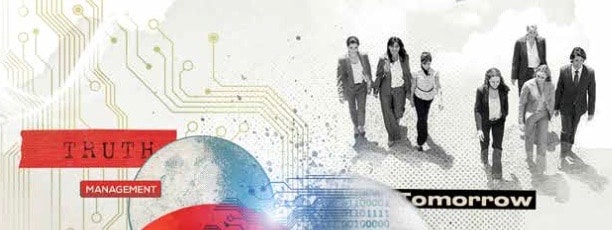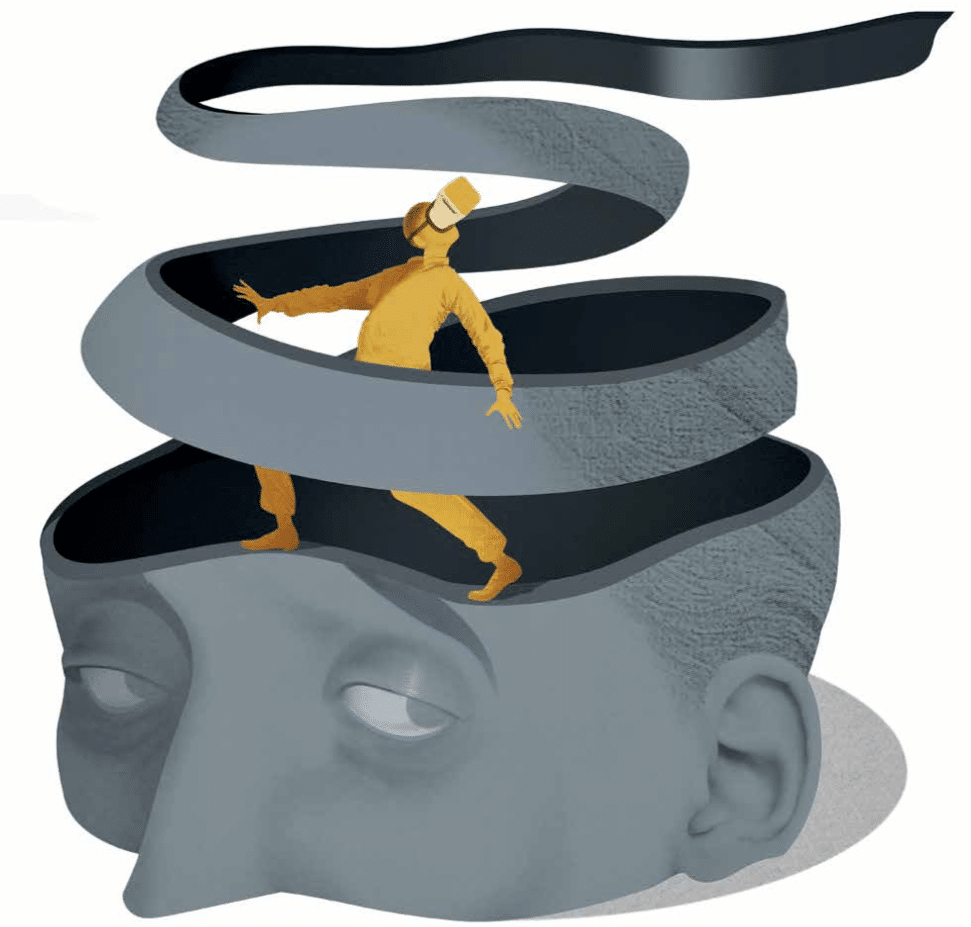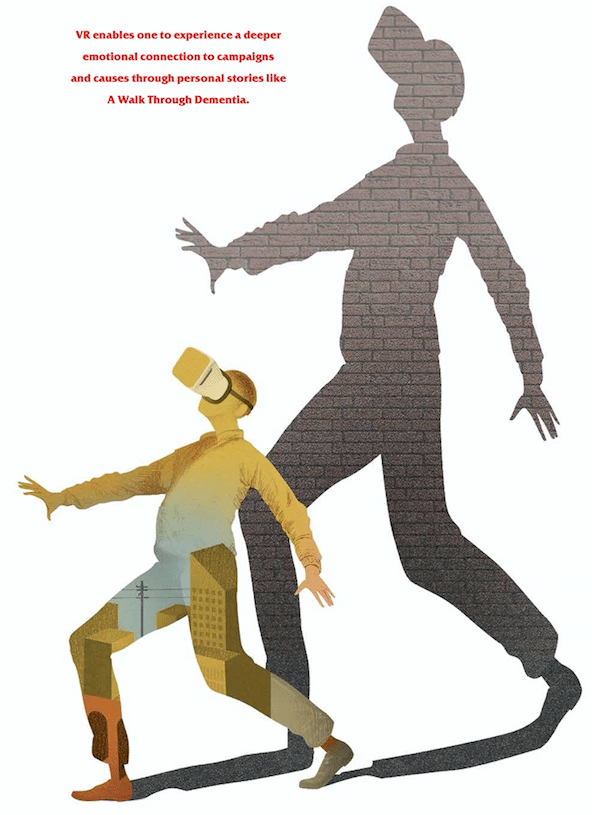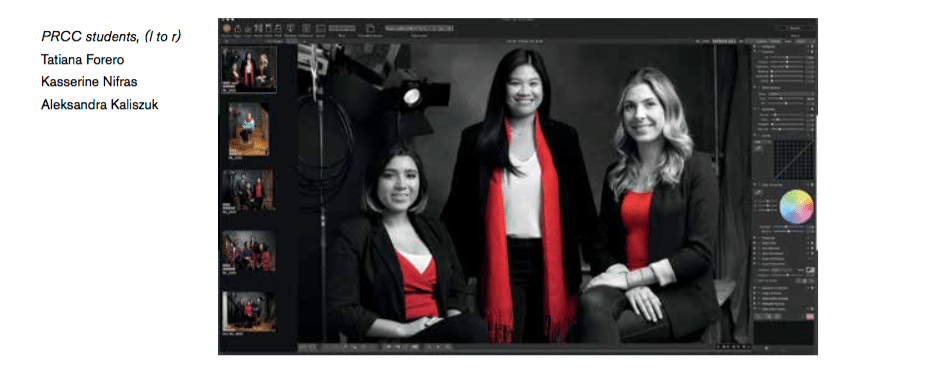Picture this: You are walking home from the store with your son and suddenly he stops to make a phone call. “I’ll be one sec,” he turns to you and says. You decide to keep walking ahead and cut through the alley to get home faster. Suddenly, your heart starts to race, your breathing becomes more shallow, and you immediately know something is terribly wrong.
A person in the distance begins to walk towards you slowly. You breathe a sigh of relief thinking it’s your son, but it’s not. “Are you alright?” the stranger asks. “Do you need help?” You are in full panic mode now and have no idea where you are, or how you got there. As the stranger is about to offer assistance, your son arrives.“She’s with me,” he says. “We’re together.”“I was so worried. Are you okay?” he asks. “Yes, yes, I’m okay,” you respond, relieved to see him.
This scenario is one of three everyday situations featured in A Walk Through Dementia, a unique Google Cardboard app presented in virtual reality. The campaign was led on behalf of Alzheimer’s Research UK, a charity aiming to defeat dementia, to put you in the shoes of someone living with the disease. Many organizations are now leveraging the power of VR to create a deeper emotional connection to their campaigns and causes through personal stories like this one.
“The challenges we were facing with dementia are that people are very dismissive of it,” says Dr. Laura Phipps, head of communications and engagement at Alzheimer’s Research UK, in Cambridge, England. “There’s a big stigma and people didn’t really want to talk about it.”
Dr. Phipps teamed up with VISYON, an innovation company, who created the 3D experience and led the development of the campaign. She says that all the scenarios in the VR app were guided by people living with different forms of dementia. Once the scenarios were established, the charity connected with Google UK who created the 3D virtual experience and released it on its platform for free.
In the past, Alzheimer’s Research UK relied on traditional communication channels to help raise awareness of this often-misunderstood condition. In fact, many people mistakenly believe dementia is just a by-product of aging. Dr. Phipps says the reality is that dementia is a condition caused by diseases—most commonly Alzheimer’s—that damage different areas of the brain leading to a variety of challenging symptoms.
In order to capture and truly immerse the audience into experiencing the common dementia feelings of disorientation, fear, and hopelessness, it was important for the charity to use a technology that would fully place users within a simulated environment where these symptoms could be experienced. They chose VR—and it worked. The campaign received 5,000 app downloads and gained international recognition, with various organizations requesting translated versions of the app.
Once upon a time, VR was only being used by the gaming industry
That’s all changed, says Michael Thibodeau, who is the HoloLens and Mixed Reality Lead at Microsoft Canada. Michael says today’s technological advances, which includes Microsoft’s HoloLens—the rst self-contained, holographic computer, enabling you to engage with your digital content and interact with holograms in the world around you—has paved the way for VR’s use in multiple sectors, including education and health care. Instead of being outsiders looking in, mixed reality allows users to be completely immersed in an alternate 3D reality, engaging with settings and environments, including touching, hearing and feeling—all the complexities of a real-life simulation.
“Mixed reality and VR will continue to grow in storytelling,” saysMr. Thibodeau. “People’s familiarity with the technology will increase, and so will their understanding of which tool to use and when.”
Brands are just scratching the surface with what can be done to leverage VR, but that doesn’t mean all audiences will be receptive to it
“It is not yet a ripe technology,” says Dr. Robert Kozinets, a globally-recognized expert on marketing research and branding. Dr. Kozinets points out that VR, due to its 3D qualities and abilities to encourage the immersive engagement of human senses, is more of an “intrusive technology” than consumers are used to. He says it requires participants to, first, have a headset on hand, and second, make conscious time dedicated to experience the event or activity at hand, as it requires both dynamic and active physical participation.
With these up-front requirements and limitations, Dr. Kozinets believes VR is not a technology meant to be used passively by your everyday commuter on the subway to work, or by your daily fast food customer, waiting around for their order.
In addition, he says the other obstacle standing in the way of VR is its cost. Although it has become much more affordable and consumer-friendly since its introduction, VR requires the appropriate equipment (a headset) and the development of a corresponding software application, which means financial resources will need to be set aside to create a truly successful VR experience.
However, all the experts agree that VR’s greatest potential can be leveraged at special events, with a predetermined location, time and set up—rather than for everyday use integrated within our daily activities.
Alzheimer’s Research UK is doing just that. In addition to its VR app, it has created an interactive learning stand that is featured at all the organization’s public events to highlight A Walk Through Dementia. If the line-up at their learning stand is any indication, their audiences don’t mind putting a little VR into their real lives.
“VR in PR” was written by first semester students Tatiana Forero, Aleksandra Kaliszuk and Kasserine Nifras. They interviewed the subjects, wrote the story, and helped direct the design.
Illustrations by Ben Weeks, Canada.
Read more from Seneca’s students and subscribe to the school’s “PR Dialogues” periodical here.






